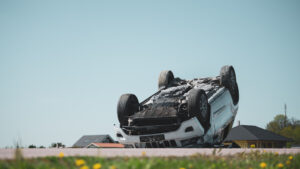A blown car tire turned into a chain-reaction pedestrian crash involving an ambulance on the interstate through Louisa County, Virginia (VA). The reported details indicate that the driver of a second car deserves blame for the wreck, but the completed police report will draw close scrutiny from insurance company representatives.
The incident began on the evening of April 12, 2018, when the driver of the first car blew a tire and ran off the road to the left. A county rescue squad ambulance needed to approach the scene near mile marker 135 on I-64 just east of Gordonsville by driving along the right shoulder because traffic had backed up behind the wrecked car.
When the ambulance got close to the disabled car, it began moving across traffic. That is when the second car rear-ended the ambulance and knocked it into the driver of the first car, who was standing on the left shoulder.
The pedestrian, identified in multiple news reports as 23-year-old Herbert Tyler III, suffered serious, but not life-threatening, injuries and went to the hospital. State troopers filed an initial charge of following too closely against the driver of the second vehicle, whom they publicly identified as 51-year-old Gerald Wolburg of Midlothian. The ambulance driver was not injured and was determined not to be at-fault for hitting the pedestrian because the emergency sirens and flashers were engaged,
If the following too closely charge remains in place, the injured pedestrian should have strong grounds for filing and collecting on personal injury insurance claims against the driver of the car that struck the ambulance from behind. While the usual rules of negligence in traffic crashes assign blame to the drive of the vehicle that most directly strikes the victim, that assumption does not appear to apply to the chain-reaction crash on I-64 in Louisa County.
Judging by the information released to the public, the ambulance driver only lost control because the second driver rear-ended the emergency vehicle. This indicates that the pedestrian would not have suffered injuries except for that other driver’s failure to give the ambulance enough space to move through traffic safely.
My three decades of experience as a Virginia person injury lawyer, though, tells me that the allegedly at-fault driver’s insurance company will dispute this conclusion. The insurer’s representatives will try to find any evidence that the ambulance driver failed to follow procedures, that the first driver endangered himself unnecessarily, and that their client did not, in fact, follow too closely. Those efforts to avoid responsibility and, ultimately, liability for paying claims are legal, so the injured pedestrian and his attorneys should be prepared to counter them with strong evidence of the other driver’s fault.
EJL

Rick Shapiro has practiced personal injury law for over 30 years in Virginia, North Carolina, and throughout the Southeastern United States. He is a Board-Certified Civil Trial Advocate by the National Board of Trial Advocacy (ABA Accredited) and has litigated injury cases throughout the eastern United States, including wrongful death, trucking, faulty products, railroad, and medical negligence claims. During his three-decade career, Shapiro has won client appeals before the VA Supreme Court, VA Court of Appeals, NC Supreme Court, SC Supreme Court, WV Supreme Court, TN Supreme Court, and three times before the United States Court of Appeals for the Fourth Circuit, underscoring Shapiro’s trial achievements. In addition, he and his law firm have won settlements/verdicts in excess of $100 million. His success in and out of the courtroom is a big reason why he was named 2019 “Lawyer of the Year” in railroad law in U.S. News & World Report's Best Lawyers publication (Norfolk, VA area), and he has been named a “Best Lawyer” and “Super Lawyer” by those peer-reviewed organizations for multiple years. Rick was also named a “Leader in the Law, Class of 2022” by Virginia Lawyers Weekly (total of 33 statewide honorees consisting of lawyers and judges across Virginia). And in September 2023, Rick was selected as a recipient of the National Board of Trial Advocacy (NBTA) 2023 President’s Award. Although many nominations were submitted from across the country, Rick was just one of eight attorneys chosen by the prestigious National Board which certifies civil trial attorneys across the U.S. Rick was also recently named to Virginia Lawyers Weekly 2024 Virginia’s Go To Lawyers Medical Malpractice. The attorneys awarded this honor are nominated by their colleagues and chosen by a panel from the publication.









Comments for this article are closed.